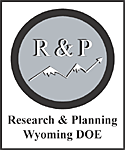The Employment Situation in Surrounding States
Colorado
The seasonally adjusted unemployment rate for Colorado edged down one-tenth of a percentage point to 7.4 percent in April, according to Donald J. Mares, Executive Director of the Colorado Department of Labor and Employment. “While this marks the first time since October 2007 that the unemployment rate has fallen, continued job losses will likely push Colorado’s unemployment rate still higher in the upcoming months,” cautioned Mares. One year ago the rate of joblessness stood at 4.7 percent.
Because results from the monthly household survey can be volatile, several months of labor force data are needed to confirm or establish trends in the estimates. After adjusting for normal seasonal labor force movements, the estimated number of employed Coloradans rose 13,200 during the month to 2,534,800. Despite this month’s increase, total employment has fallen 62,900 over the past 12 months. Unemployment declined by 2,200 during the month to 201,300. The number of Colorado residents unsuccessfully seeking work has risen 74,000 since last April. (Source: http://www.coworkforce.com/lmi/ali/APR09PR.HTM)
Montana
Montana’s seasonally-adjusted unemployment rate decreased slightly to
6.0% for April 2009 from 6.1% in March. The national rate rose over the
month, increasing from 8.5% to 8.9%.
Montana’s seasonally-adjusted, nonagricultural payroll employment grew
by 1,500 jobs (+0.3%) from March to April 2009. The total government sector
showed the largest gains, with 1,000 jobs (+1.1%) added over the month.
Professional and Business Services also experienced a significant increase
with 600 new jobs (+1.6%). (Source: http://www.ourfactsyourfuture.org/admin/uploadedPublications/
3512_eag_apr09.pdf)
Utah
Utah’s nonfarm wage and salaried job count for April 2009, as generated by the United States Bureau of Labor Statistics (BLS), contracted by 3.2 percent. Approximately 39,800 jobs have been removed from the Utah economy over the past year, lowering total wage and salary employment to 1,219,100. March’s employment contraction has been revised downward, from -2.6 percent initially reported, to -2.7 percent.
Utah’s other primary indicator of current labor market conditions, the seasonally adjusted unemployment rate, held steady at 5.2 percent in April. Last April, the state’s rate was 3.3 percent, a 1.9 percentage-point increase over the past 12 months. Approximately 71,100 Utahns were considered unemployed in April 2009, compared against 45,700 last April, an increase of 25,400 unemployed workers. The United States unemployment rate continued to rise, reaching 8.9 percent for April.
Mark Knold, chief economist for the Department of Workforce Services, commented, “At this point, it is just a matter of sitting back and letting time progress. The economy is performing as anticipated by this time of year—that is, more job losses with more to come. We anticipate that the job losses will show a marked slowdown by the late fall of this year, therefore it’s just a matter of riding out the summer. We do believe that the worst of the economic problems are behind us, but there is no imminent economic recovery in front of us either. The credit markets are just not ready to finance that yet, and Utah’s housing market still has more adjustments to work through. 2010 offers the first opportunity for economic revival, so it’s just a matter of marking time.” (Source: http://jobs.utah.gov/opencms/wi/press/2001press/ratemay09.pdf)
Idaho
Coming off of the lowest February-to-March growth since World War II, Idaho had a welcome seasonal increase in April. Employers added 3,000 jobs to their payrolls, bringing total nonfarm jobs in the state to 614,800. But the increase of 0.49 percent was just half the average 0.98 percent Idaho has been used to for the past several few years. Year-over-year the state is down more than 30,000 jobs, or 4.75 percent.
According to the Bureau of Labor Statistics, construction added 1,400 jobs. The 3.84 percent increase was just one full percentage point below the five-year average of 4.93 percent, something that has not occurred since construction experienced seven consecutive months of jobs lost before April. Even with the seasonal increase, there were 6,800 fewer jobs in construction than last year, and the 38,000 jobs remaining in that sector left construction at a level last seen in 2004.
Construction’s good news was tempered with the performance of manufacturing, impacted by persisting layoffs in the high technology sector. The 300 jobs lost in April represented another half-percentage point decline from March, leaving manufacturing 7,000 jobs short of a year ago. Since August 2007, when high-tech employment began to slide, the state has lost 10,500 manufacturing jobs to drop below 57,000. Manufacturing in Idaho is now at the level reported in April 1992. (Source: http://labor.idaho.gov/lmi/pubs/idempnews/iecur.pdf)
Nebraska
Nebraska’s estimated seasonally adjusted state unemployment rate decreased to 4.4% in April 2009, according to data released today by the Nebraska Workforce Development – Department of Labor. The rate reflects an increase of 1.1% over last year’s April 2008 rate.
The national rate for April 2009 increased to 8.9%. This is 3.9% higher than last year’s April 2008 rate of 5.0%.
Labor Commissioner Catherine D. Lang said, “Over the year, Educational and Health Services (+1,764 jobs, +1.3%) was the only major private industry to show growth. All other industries declined over the year with Manufacturing (-7,971 jobs, -7.8%) and Professional & Business Services (-7,015, -6.6%) having the largest decreases.” (Source: http://www.dol.state.ne.us/nwd/pdf/apr09pr.pdf)
South Dakota
South Dakota’s preliminary seasonally adjusted unemployment rate was 4.8% in April 2009, compared to the revised March 2009 rate of 4.9%. This slight drop is related to a decrease in the number of unemployed. (See related data.) Meanwhile, the national unemployment rate continued to rise, increasing over the month from 8.5% in March to 8.9% in April.
The state’s April 2009 unemployment rate of 4.8% has increased nearly
two full percentage points compared to the April 2008 rate of 2.9%.
The unemployment rate represents the number of unemployed as a percentage
of the labor force. People are classified as unemployed if they do not
have jobs, have actively looked for work in the prior four weeks and are
currently available for work. (Source: http://dol.sd.gov/lmic/overview.aspx)
